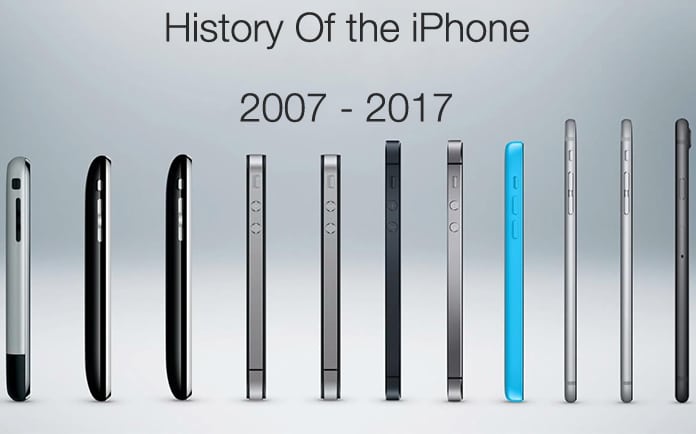The iPhone, introduced by Apple Inc. in 2007, has undoubtedly revolutionized the smartphone industry with its cutting-edge design, technology, and software integration. Each iteration of the iPhone has brought significant enhancements, elevating user experience to unprecedented levels. Let’s embark on a journey to explore the features and progress of each iPhone model from the original iPhone to the latest models of 2022.
I. The Original iPhone (iPhone 1st Generation, 2007)
- Design and Display: The first iPhone featured a 3.5-inch display with a resolution of 320 x 480 pixels. It had a revolutionary design with just a few physical buttons and a large touchscreen.
- Operating System: It ran on iPhone OS 1, which later evolved into iOS.
- Camera and Storage: The iPhone offered a 2 MP rear camera and was available in 4GB, 8GB, and 16GB storage variants.
II. iPhone 3G (2008)
- Design and Display: Similar in design to the original iPhone, it introduced a plastic back.
- Network: The key upgrade was the support for 3G networks for faster internet connectivity.
- Operating System: It launched with iPhone OS 2.0 and introduced the App Store.
III. iPhone 3GS (2009)
- Speed and Performance: The “S” in the 3GS stood for speed, reflecting its improved performance.
- Camera: The 3GS had a 3 MP camera, capable of video recording.
- Operating System: It ran on iPhone OS 3.0 which brought new features like Cut, Copy, and Paste.
IV. iPhone 4 (2010)
- Design: The iPhone 4 introduced a new design with a glass front and back and a stainless-steel frame.
- Display: It featured a high-resolution “Retina Display.”
- Camera: It had a 5 MP rear camera and introduced a front-facing camera for FaceTime.
V. iPhone 4S (2011)
- Processor and Camera: The 4S introduced the A5 chip and an 8 MP camera.
- Software: It launched with iOS 5 and introduced Siri, Apple’s voice assistant.
- Connectivity: It offered improved cellular connectivity and Bluetooth 4.0.
VI. iPhone 5 (2012)
- Design and Display: The iPhone 5 had a lighter and thinner design with a 4-inch display.
- Processor: It was powered by the new A6 chip.
- Connectivity: It introduced the Lightning connector and had 4G LTE support.
VII. iPhone 5S and 5C (2013)
- Processor and Security: The 5S featured the A7 chip and introduced Touch ID.
- Design: The 5C was available in various colors and had a plastic body.
VIII. iPhone 6 and 6 Plus (2014)
- Design and Display: They featured larger displays of 4.7 and 5.5 inches and a new rounded design.
- Processor: They were powered by the A8 chip.
IX. iPhone 6S and 6S Plus (2015)
- Processor and Camera: They featured the A9 chip and a 12 MP camera.
- 3D Touch: Introduced 3D Touch which allowed different responses based on touch pressure.
X. iPhone SE (2016)
- Design: Compact design similar to the iPhone 5S.
- Processor: It was powered by the A9 chip.
XI. iPhone 7 and 7 Plus (2016)
- Design: They eliminated the headphone jack.
- Camera: The 7 Plus featured a dual-camera setup.
- Processor: Powered by the A10 Fusion chip.
XII. iPhone 8 and 8 Plus (2017)
- Design and Charging: They introduced a glass back and wireless charging.
- Processor: Powered by the A11 Bionic chip.
XIII. iPhone X (2017)
- Design and Display: The X featured a nearly bezel-less design and OLED Super Retina Display.
- Face ID: It introduced Face ID facial recognition technology.
- Processor: Powered by the A11 Bionic chip.
XIV. iPhone XS, XS Max, and XR (2018)
- Display and Design: XS and XS Max had OLED displays, and the XR had an LCD display.
- Processor: Powered by the A12 Bionic chip.
XV. iPhone 11, 11 Pro, and 11 Pro Max (2019)
- Camera: The Pro models featured a triple-camera system.
- Processor: Powered by the A13 Bionic chip.
XVI. iPhone SE (2020)
- Design: Similar to the iPhone 8.
- Processor: Powered by the A13 Bionic chip.
XVII. iPhone 12, 12 mini, 12 Pro, and 12 Pro Max (2020)
- Design and Connectivity: They introduced 5G connectivity and featured a new flat-edge design.
- Processor: Powered by the A14 Bionic chip.
XVIII. iPhone 13, 13 mini, 13 Pro, and 13 Pro Max (2021)
- Processor: Powered by the A15 Bionic chip.
- Camera and Display: Improved camera capabilities and ProMotion display on Pro models.
Progress Story:
From the original iPhone to the iPhone 13, the evolution story is a testament to Apple’s commitment to innovation, design, and technology integration. The iPhone revolutionized the smartphone industry by setting new standards for smartphones’ design, functionality, and integration with other devices and services. The initial models laid the foundation, with advancements in display technology, processing power, camera capabilities, and software features with each new release.
The iPhone 4 marked a significant design shift, introducing a more modern, flat design with metal and glass components. This design language was further refined in subsequent models. The introduction of larger screen sizes with the iPhone 6 and 6 Plus met consumers’ demand for more screen real estate and solidified Apple’s position in the growing phablet market.
With the iPhone X, Apple moved towards an almost bezel-less design, introducing the notch to accommodate the Face ID sensors while providing a more immersive display experience. This design has been carried over to the latest models, with iterative improvements in display technology, camera systems, and internal components.
In terms of software, the introduction of the App Store with iPhone OS 2.0 opened up a world of possibilities for third-party developers and created a robust ecosystem of apps and services around the iPhone. With the introduction of Siri in the iPhone 4S, Apple pioneered the integration of voice-activated virtual assistants into smartphones, a feature now ubiquitous across the industry.
In conclusion, over the years, the iPhone has consistently pushed the boundaries of what is possible with a smartphone, delivering improvements in design, functionality, and performance with each new model. The iPhone’s evolution showcases Apple’s dedication to providing users with top-of-the-line technology, seamless software integration, and an overall unparalleled user experience. As we look towards the future, it is exciting to imagine the innovative features and advancements that upcoming iPhone models will bring, as Apple continues



